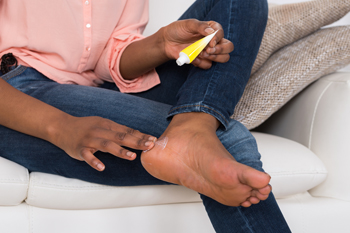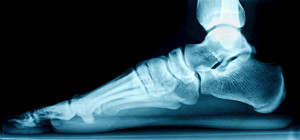Connect With Us
Blog
Items filtered by date: May 2024
Causes And Treatment Of Cracked Heels

Cracked heels often stem from various factors, including obesity, wearing ill-fitting shoes, prolonged standing, and dry skin. When the skin on your feet lacks moisture and becomes stiff, it is more susceptible to cracking, especially under pressure while standing or walking. Certain conditions, such as diabetes, psoriasis, and flat feet, can further dry out the skin and increase the risk of cracked heels or painful fissures. Preventative measures include moisturizing regularly, avoiding harsh soaps, and opting for closed-heeled shoes with ample cushioning. Wearing cotton socks can also help to reduce friction. Mild relief typically involves moisturizers containing ingredients like urea or hyaluronic acid, which help retain moisture and soften the skin. While mild cases can often be managed at home, it is important to see a podiatrist if heel cracks are associated with a medical condition or if they have become infected. Seeking professional advice ensures a proper diagnosis and treatment, leading to quicker healing and long-term foot health. If cracked and painful heels are causing you discomfort, it is suggested that you schedule an appointment with a podiatrist.
Cracked heels are unsightly and can cause further damage to your shoes and feet. If you have any concerns, contact one of our podiatrists from Bergen Foot & Ankle. Our doctors can provide the care you need to keep you pain-free and on your feet.
Cracked Heels
Cracked heels appear unappealing and can make it harder for you walk around in sandals. Aside from looking unpleasant, cracked heels can also tear stockings, socks, and wear out your shoes. There are several methods to help restore a cracked heel and prevent further damage.
How Do You Get Them?
Dry skin is the number one culprit in creating cracked heels. Many athletes, walkers, joggers, and even swimmers suffer from cracked heels. Age and skin oil production play a role to getting cracked heels as well.
Promote Healing
Over the counter medicines can help, especially for those that need instant relief or who suffer from chronic dry feet.
Wear Socks – Wearing socks with medicated creams helps lock in moisture.
Moisturizers – Applying both day and night will help alleviate dryness which causes cracking.
Pumice Stones – These exfoliate and remove dead skin, which allows for smoother moisturizer application and better absorption into the skin.
Change in Diet
Eating healthy with a well-balanced diet will give the skin a fresh and radiant look. Your body responds to the kinds of food you ingest. Omega-3 fatty acids and zinc supplements can also revitalize skin tissue.
Most importantly, seek professional help if unsure how to proceed in treating cracked heels. A podiatrist will help you with any questions or information needed.
If you have any questions, please feel free to contact our offices located in Fort Lee, NJ and Flushing, NY . We offer the newest diagnostic and treatment technologies for all your foot care needs.
Common Reasons Behind Foot Blisters

Foot blisters are uncomfortable and often arise from a variety of common causes. Friction stands as a primary instigator, occurring when shoes or socks rub against the skin, particularly during vigorous physical activities or prolonged periods of standing or walking. Wearing ill-fitting footwear worsens this friction, creating hot spots that gradually develop into blisters. Moisture, another adversary, softens the skin, making it more susceptible to friction-induced damage. Wet conditions, sweaty feet, or improperly dried footwear create an ideal environment for blister formation. Furthermore, heat plays a significant role, as excessive warmth can increase friction and moisture levels, intensifying blister formation. Conversely, extreme cold can also contribute, causing skin to become brittle and more prone to friction injuries. Foot blisters can become infected if not promptly treated. If you have a bothersome blister, it is suggested that you visit a podiatrist who can treat it and offer additional prevention methods.
Blisters may appear as a single bubble or in a cluster. They can cause a lot of pain and may be filled with pus, blood, or watery serum. If your feet are hurting, contact one of our podiatrists of Bergen Foot & Ankle. Our doctors can provide the care you need to keep you pain-free and on your feet.
Foot Blisters
Foot blisters are often the result of friction. This happens due to the constant rubbing from shoes, which can lead to pain.
What Are Foot Blisters?
A foot blister is a small fluid-filled pocket that forms on the upper-most layer of the skin. Blisters are filled with clear fluid and can lead to blood drainage or pus if the area becomes infected.
Symptoms
(Blister symptoms may vary depending on what is causing them)
- Bubble of skin filled with fluid
- Redness
- Moderate to severe pain
- Itching
Prevention & Treatment
In order to prevent blisters, you should be sure to wear comfortable shoes with socks that cushion your feet and absorb sweat. Breaking a blister open may increase your chances of developing an infection. However, if your blister breaks, you should wash the area with soap and water immediately and then apply a bandage to the affected area. If your blisters cause severe pain it is important that you call your podiatrist right away.
If you have any questions, please feel free to contact our offices located in Fort Lee, NJ and Flushing, NY . We offer the newest diagnostic and treatment technologies for all your foot care needs.
Salvaging Limbs and Preserving Mobility in Diabetic Patients

For individuals with diabetes, limb salvage is a critical aspect of managing the condition and maintaining quality of life. Diabetes can lead to complications such as peripheral artery disease and neuropathy, increasing the risk of foot ulcers and infections that may ultimately require limb amputation if left untreated. To salvage limbs, implementing proactive measures is essential. Regular foot exams by a podiatrist can identify potential issues early. Diabetic patients should prioritize foot care, including daily inspection, proper hygiene, and moisturizing to prevent dry skin. Wearing well-fitted shoes and avoiding walking barefoot can also reduce the risk of injuries. Managing blood sugar levels through medication, diet, and exercise is critical in preserving vascular health and nerve function. Any foot wounds should receive immediate attention, with proper cleaning and dressing to promote healing and prevent infection. By prioritizing preventive care and early intervention, diabetic patients can minimize the risk of limb loss and maintain mobility for a better quality of life. If you have diabetes, it is strongly suggested that you are under the care of a podiatrist who can help you to manage this condition and guide you toward important tactics that may help to salvage damaged limbs.
Diabetic Limb Salvage
Diabetic limb salvage can be an effective way in preventing the need for limb amputation. If you have a foot ulcer and diabetes, consult with one of our podiatrists from Bergen Foot & Ankle. Our doctors will assess your condition and provide you with quality foot and ankle treatment.
What Is Diabetic Limb Salvage?
Diabetic limb salvage is the attempt of saving a limb, such as the foot, that has an infected ulcer, from amputation. Podiatrists also try to make sure that there is enough function in the foot after the salvage that it is still usable. Those with diabetes experience poor blood circulation, which prevents proper healing of an ulcer. If the ulcer is left uncheck, it could become infected, which could result in the need for amputation.
Diabetes is the number one cause of non-traumatic amputations in the United States. Amputation has been found to lead to higher mortality rates. This translates into higher healthcare costs, and a reduced quality of life and mobility for amputees. Podiatrists have attempted to increase the prevalence of limb salvage in an attempt to solve these issues.
Diagnosis and Treatment
Limb salvage teams have grown in recent years that utilize a number of different treatments to save the infected limb. This includes podiatrists that specialize in wound care, rehabilitation, orthotics, and surgery. Through a combination of these methods, limb salvage has been found to be an effective treatment for infected limbs, and as an alternative to amputation. Podiatrists will first evaluate the potential for limb salvage and determine if the limb can be saved or must be amputated.
If you have any questions, please feel free to contact our offices located in Fort Lee, NJ and Flushing, NY . We offer the newest diagnostic and treatment technologies for all your foot care needs.
Benefits and Drawbacks of Flat Foot Surgery

Surgery for flat feet, also known as flatfoot reconstruction, presents individuals with both advantages and disadvantages to consider before making a decision. On the positive side, surgery can correct structural abnormalities, realign bones and tendons, and restore the arch of the foot, potentially alleviating pain and improving mobility. For individuals experiencing severe symptoms or those whose quality of life is significantly affected by flat feet, surgery can offer long-term relief and enhanced functionality. However, it is essential to weigh the potential drawbacks. Surgery entails inherent risks, including infection, nerve damage, and prolonged recovery periods. Additionally, the success of the procedure may vary, and there's no guarantee of complete symptom resolution. Furthermore, undergoing surgery requires a commitment to post-operative rehabilitation and lifestyle adjustments, such as avoiding high-impact activities and wearing supportive footwear. If you have flat feet that are causing you discomfort, it is suggested that you consult a podiatrist who can help you determine if surgery is right for you.
Foot surgery is sometimes necessary to treat a foot ailment. To learn more, contact one of our podiatrists of Bergen Foot & Ankle. Our doctors will assist you with all of your foot and ankle needs.
When Is Surgery Necessary?
Foot and ankle surgery is generally reserved for cases in which less invasive, conservative procedures have failed to alleviate the problem. Some of the cases in which surgery may be necessary include:
- Removing foot deformities like bunions and bone spurs
- Severe arthritis that has caused bone issues
- Cosmetic reconstruction
What Types of Surgery Are There?
The type of surgery you receive will depend on the nature of the problem you have. Some of the possible surgeries include:
- Bunionectomy for painful bunions
- Surgical fusion for realignment of bones
- Neuropathy decompression surgery to treat nerve damage
Benefits of Surgery
Although surgery is usually a last resort, it can provide more complete pain relief compared to non-surgical methods and may allow you to finally resume full activity.
Surgical techniques have also become increasingly sophisticated. Techniques like endoscopic surgery allow for smaller incisions and faster recovery times.
If you have any questions please feel free to contact our offices located in Fort Lee, NJ and Flushing, NY . We offer the newest diagnostic and treatment technologies for all your foot and ankle needs.

